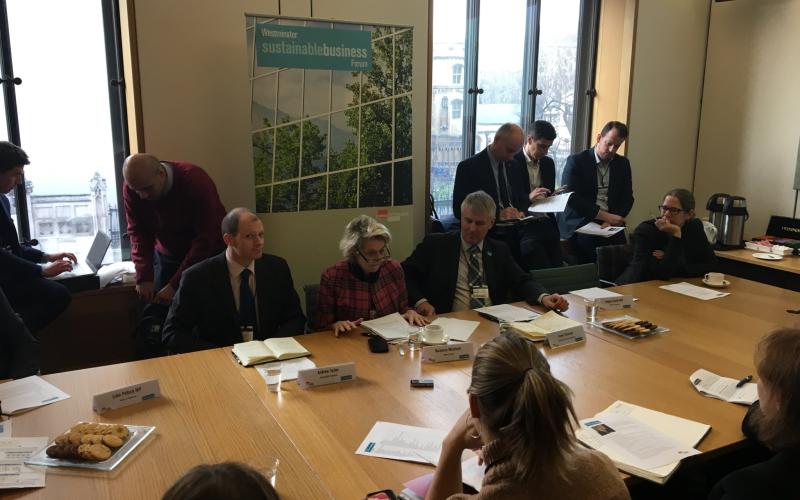Promote and record greenspace in housing developments, says experts at WSBF meeting
The WSBF wanted to look at the potential benefits of getting more sustainable drainage systems (SuDS) into housing developments.
There are growing concerns that urban greenspace in England is being lost (-7% since 2001) to hard surfaces like housing and roads. Loss of permeable surfaces mean that rainfall will have less places to drain, overloading the sewers and potentially causing localised flooding. This roundtable was chaired by Baroness Anne McIntosh of Pickering, Bricks & Water co-chair, Conservative Peer of the House of Lords and former Chair of the EFRA Select Committee. Expert speakers were:
- Innes Thomson from the Association of Drainage Authorities
- Clare Warburton from Natural England
- Andrew Taylor from Countryside Properties
This was the third of the follow-up events to WSBF's Bricks & Water report which looked blue-green infrastructure features and there provision in England. Some of the questions we sought to answer were:
- What do we mean by 'sustainable drainage', and how can it improve water management?
- Who pays for the installation of SuDS into housing developments? Do housebuilders have the proper incentives to build SuDS?
- Who should be responsible for the maintenance of SuDS - councils, management companies or water companies?
- Do we properly account for the multiple benefits (biodiversity, amenity, water quality etc) of 'green' SuDs?
- According to Natural England, 93% of people want open green space near to where they live. Is this evidence that we need more SuDS retrofit into urban spaces?
The key points were:
- Sustainable Drainage Systems (SuDS) increase urban greenspace and have multiple societal benefits. The four pillars of SuDS are improving water quality; better water runoff control and managing flood risk; biodiversity benefits through creating habitats for nature; amenity and placemaking benefits for residents.
- Much of the drainage that is currently built in housing estates is not sustainable. SuDS mimic natural processes by attenuating water through topsoil and a vegetated layer, rather than allowing rainwater to run off a hard impermeable surfaces like concrete. SuDS include green infrastructure features such as grass buffer strips, swales and ponds.
- The planning service is underfunded and overburdened, which is causing delays to housing growth and sub-optimal development. Local authority planners continue to be hampered by lack of capacity and in some cases knowledge and experience. Whilst the Government plans to update SuDS guidance, planners are struggling to implement existing guidance to a satisfactory standard.
- Early engagement in planning is crucial for delivering SuDS. For SuDS to achieve multiple benefits they need to be designed into housing developments from the earliest stage possible, before the planning application is submitted. Early engagement between the developer and the Lead Local Flood Authority (LLFA) is crucial for fully integrated SuDS to be designed and built. Ideally SuDS advocates (e.g. LLFA) need to engage before the land is bought for development.
- The legislative framework for domestic SuDS at the moment is relatively weak. The Flood and Water Management Act 2010 was not fully implemented, which has stunted the uptake of SuDS in some places. The removal of the Code for Sustainable Homes in 2015 was viewed as a further negative signal to the market. Updating the Non-Statutory Technical Standards (NSTS) and National Planning Policy Guidance (NPPG) to advocate for the multiple benefits of SuDS will give more power to LLFAs to demand that these multiple benefits are realised.
- SuDS delivery on the ground remains inconsistent and fragmented across the country. A quarter (25%) of local authorities have no formal policy on SuDS (Landscape Institute). More connection needs to be made with overarching Government policy on SuDS and how the policies are implemented on the ground by local authorities.
WSBF recommends:
- Extensive development of flood plains and other high flood risk areas should be avoided and discouraged through government guidance and the planning system. SuDS retrofit of urban environments is also crucial to achieving catchment scale management of water. Ofwat should give the water companies regional targets for SuDS retrofit, habitat restoration and tree planting.
- The Government should revise the standards and guidance for sustainable drainage to account for their multiple benefits. Currently the government guidance only covers conveying water quantity on site to avoid flooding events.
- The Government should establish a central record of SuDS features, and update the flood risk maps available to planners with the latest climate projections. The SuDS record should be kept by DEFRA would provide data on how widely SuDS are used. This would also help update flood maps with pluvial flood risk, so that planners can make a more informed assessment on the flood risk of a planning application. The government should also review the automatic right to connect for developers to surface water drainage from the site to sewers.
- Water and sewerage companies in England should be encouraged to move to an area-based charging system for drainage. There is not a financial incentive for them to do this, so Ofwat should provide incentives for them in the business planning process. Area-based charging for drainage would offer a financial motivation to fit SuDS and also reflect the polluter-pays principle of the Government’s 25-year Environment Plan (25YEP). Ofwat could also give the water companies targets for SuDS retrofit, habitat restoration and tree planting.
- Ofwat should look to combine each company’s 25-year Water Resource Management Plan (WRMP) and Drainage and Wastewater Management Plans (DWMP) into a single plan. This would allow a full long term vision to be outlined for the catchment for each geographical region of England. Currently DWMPs and WRMPs are not even produced on the same timescale.
- Water companies should become statutory consultees on individual planning applications, as they are for Local Plans. This would enable water companies to become more aware of development happening in their region and result in fewer delays to housing growth.





